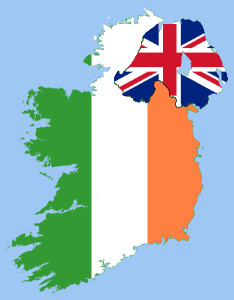The Anglo-Irish Treaty and the Constitution of Ireland that followed restricted the rights and freedom of the Irish people while they simultaneously attempted to reconcile the abuse the country had endured in its long history of conflict and uncertain ruling. These documents established physical and figurative borders and boundaries within the country of Ireland in a paradoxical effort to both separate and unify the people. When the contents of their new governing document, the Constitution of Ireland, were made public, the Irish population would recognize the potential for a similar kind of national instability that had already been encountered in the Anglo-Irish Treaty sixteen years previous to the formation of the Constitution.
Much of the Anglo-Irish Treaty indicates a desire for a smooth transition away from British interference in Ireland, while at the same time, measures were taken to ensure Ireland was not completely free from British presence. The British successfully managed to maintain connections with Ireland while they also established a boundary of separation between them and the people of Ireland. In 1937, sixteen years after the enactment of the Anglo-Irish Treaty, the Constitution of Ireland was created. The document established the rights and laws of the people of the Republic of Ireland. The Constitution attempted to claim from its beginning that “The national territory consists of the whole island of Ireland,” before an amendment was made decades later to delete this particular passage. The Constitution of Ireland was meant to unify and celebrate the people of Ireland, but instead, it tried to control them and the (legally separate) nation of Northern Ireland and perpetuated national instability.
Both the Treaty and the Constitution failed in their goals of easing the tensions within the country. While the new legislation may have been met with some success, it also caused new issues and questions that would be scrutinized and spoken out against for the coming decades. Ireland was marked by many centuries of struggle for survival and proved its incredible capacity to endure long years of suffering, so it may have grown used to unstable grounds and little victories won over bit by bit. Ireland had a great task to take on once Great Britain withdrew much of its political hold with the enactment of the Anglo-Irish Treaty, and Ireland got off to a shaky start. From the beginning, the Republic of Ireland was faced with the majority of its population’s desire to unify the island of Ireland, but it was also presented with the problem of what it should do with Northern Ireland, and more importantly, what it could do. Unfortunately, the Treaty and the Constitution proved incapable of resolving Ireland’s history of conflict and disunity at their creation, and instead successfully caused a great deal of upheaval and unrest in the country. Many Irish citizens may have been in support of keeping the island together for the geographical sense it made, but borders and boundaries are hardly ever tied up so neatly. Certainly, the borders separating Northern Ireland from the Republic of Ireland seem almost arbitrarily drawn, however, those very same borders were the source of a great deal of conflict within Ireland, as well were the wider borders between Ireland and Great Britain. The disruption caused by the conflict of how to separate groups of people still survives today, and is memorialized within the invisible boundaries drawn between the different nations.

